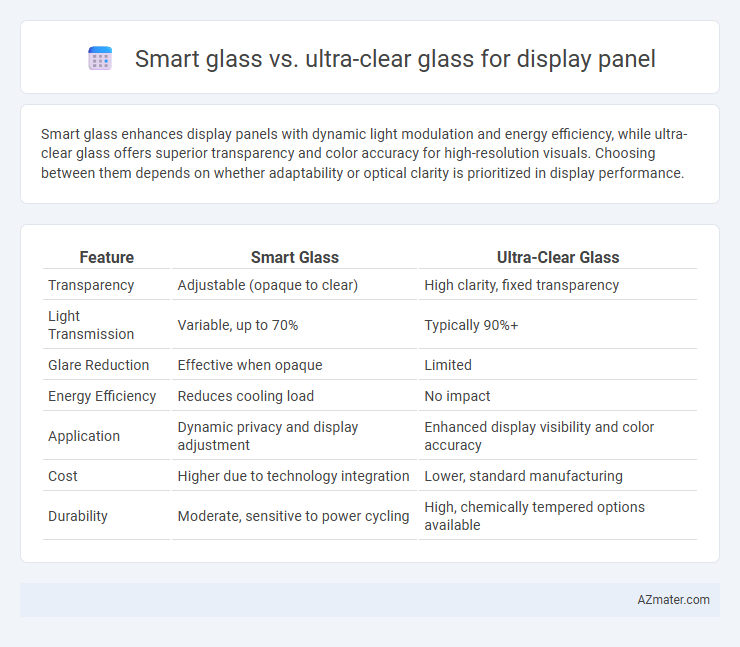Smart glass enhances display panels with dynamic light modulation and energy efficiency, while ultra-clear glass offers superior transparency and color accuracy for high-resolution visuals. Choosing between them depends on whether adaptability or optical clarity is prioritized in display performance.
Table of Comparison
| Feature | Smart Glass | Ultra-Clear Glass |
|---|---|---|
| Transparency | Adjustable (opaque to clear) | High clarity, fixed transparency |
| Light Transmission | Variable, up to 70% | Typically 90%+ |
| Glare Reduction | Effective when opaque | Limited |
| Energy Efficiency | Reduces cooling load | No impact |
| Application | Dynamic privacy and display adjustment | Enhanced display visibility and color accuracy |
| Cost | Higher due to technology integration | Lower, standard manufacturing |
| Durability | Moderate, sensitive to power cycling | High, chemically tempered options available |
Introduction to Display Panel Technologies
Smart glass technology for display panels offers dynamic control of transparency and light transmission through electrochromic or liquid crystal layers, enabling energy-efficient privacy and anti-glare solutions. Ultra-clear glass, characterized by its low iron content and high optical clarity, enhances color accuracy and brightness in display panels, making it ideal for premium screens and high-definition visuals. Both technologies play crucial roles in modern display innovations, optimizing user experience through improved visual performance and interactive capabilities.
What is Smart Glass?
Smart glass, also known as switchable glass, is a dynamic material that can change its light transmission properties in response to electrical, thermal, or light stimuli, enhancing display panel versatility by allowing real-time control of opacity and privacy. This technology incorporates liquid crystal or electrochromic layers that adjust transparency, providing superior glare reduction and energy efficiency compared to ultra-clear glass, which maintains constant high clarity without modulation capabilities. Smart glass improves user interaction and visual comfort in display panels by enabling adaptive light filtering and privacy settings, making it ideal for advanced electronic devices and smart environments.
What is Ultra-clear Glass?
Ultra-clear glass, also known as low-iron glass, features significantly reduced iron content compared to standard glass, resulting in enhanced transparency and minimal green tint, making it ideal for display panels requiring true color representation. This type of glass offers superior light transmittance of over 90%, ensuring vibrant image clarity and increased brightness for high-definition screens. In contrast to smart glass, which changes opacity for privacy or energy control, ultra-clear glass prioritizes maximum optical clarity and color accuracy for premium visual performance in displays.
Key Differences Between Smart Glass and Ultra-clear Glass
Smart glass adjusts transparency through electrical signals, offering dynamic control over light and privacy, while ultra-clear glass maintains consistent, high optical clarity with minimal haze for optimal display visibility. Smart glass often integrates conductive coatings to enable switchable opacity, whereas ultra-clear glass prioritizes low iron content to enhance color accuracy and brightness in display panels. The choice hinges on application needs--smart glass excels in privacy and energy savings, while ultra-clear glass is ideal for displays demanding maximum transparency and color fidelity.
Visual Clarity and Transparency Comparison
Smart glass offers adjustable transparency by changing its opacity with electrical input, providing variable visual clarity suited for privacy or glare reduction, but it may slightly reduce overall display brightness and sharpness compared to ultra-clear glass. Ultra-clear glass is engineered with low iron content and enhanced optical properties, delivering superior transparency and maximum light transmission, resulting in higher display clarity and true color reproduction. For applications requiring consistent high visual clarity and transparency, ultra-clear glass outperforms smart glass in minimizing color distortion and preserving image fidelity.
Energy Efficiency and Power Consumption
Smart glass reduces energy consumption by dynamically controlling light transmission, decreasing the need for artificial lighting and air conditioning in display panels. Ultra-clear glass offers minimal light distortion and high transparency but lacks active energy-saving capabilities, resulting in higher power requirements for backlighting and cooling systems. Energy efficiency in display panels is significantly enhanced with smart glass due to its adaptive opacity features, which optimize power usage across varying environmental conditions.
Durability and Maintenance Requirements
Smart glass for display panels offers enhanced durability due to its ability to resist scratches and impact, making it ideal for high-traffic environments. Ultra-clear glass provides superior optical clarity but generally requires more frequent cleaning and maintenance to prevent smudges and fingerprints from compromising display quality. Both materials demand careful handling, yet smart glass often reduces long-term upkeep costs through its robust surface properties.
Cost Analysis: Smart Glass vs Ultra-clear Glass
Smart glass typically incurs higher production and installation costs compared to ultra-clear glass due to its integrated technology and electrical components. Ultra-clear glass offers a more budget-friendly option for display panels, providing excellent optical clarity without the premium features or energy requirements of smart glass. Cost analysis reveals that while smart glass elevates display functionality, ultra-clear glass remains economically advantageous for projects prioritizing cost-efficiency and visibility.
Applications in Display Panel Industry
Smart glass enhances display panels by enabling dynamic transparency control, ideal for interactive signage, automotive HUDs, and privacy-focused devices. Ultra-clear glass offers superior light transmittance above 92%, ensuring vibrant color accuracy and enhanced brightness for premium TVs, smartphones, and high-resolution monitors. Selecting the appropriate glass depends on balancing transparency modulation capabilities with optical clarity requirements in display panel applications.
Choosing the Right Glass for Display Panels
Smart glass offers dynamic light modulation and privacy control, making it ideal for interactive and adaptive display panels, while ultra-clear glass provides superior optical clarity and color accuracy, essential for high-resolution visuals and vibrant image quality. Choosing the right glass depends on the application: smart glass suits environments requiring light control and energy efficiency, whereas ultra-clear glass is preferred for displays demanding maximum transparency and visual fidelity. Manufacturers must balance factors such as transparency, light transmittance, durability, and cost to optimize performance for their specific display panel needs.

Infographic: Smart glass vs Ultra-clear glass for Display panel
 azmater.com
azmater.com